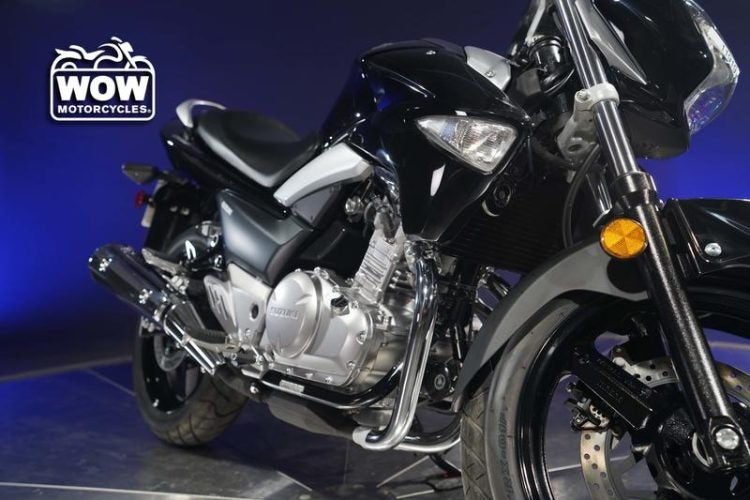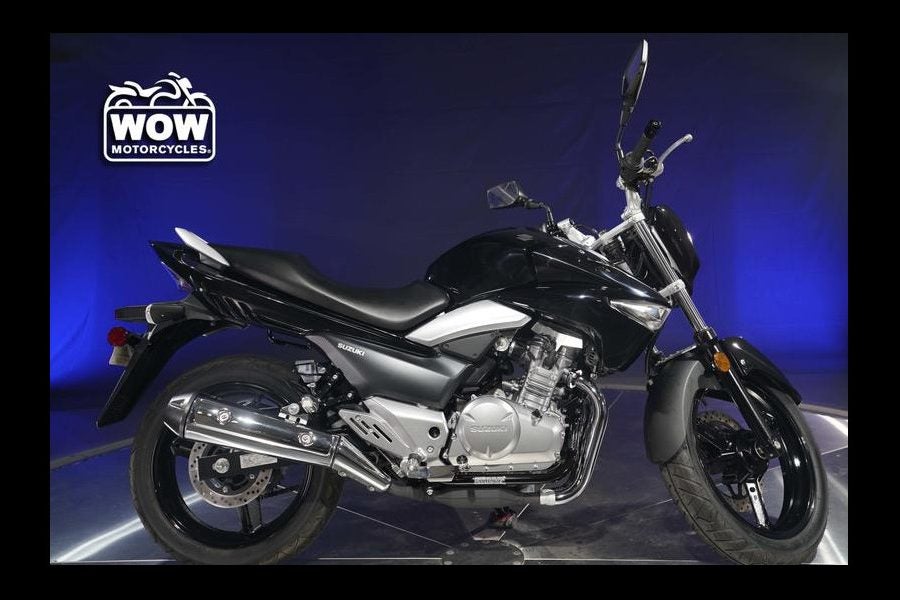Remember back about a decade ago, when gas was cheap and we all had money in our pockets? Back then, Honda’s CBR250 had single-handedly made the Kawasaki Ninja 250 obsolete, so Kawi responded with the Ninja 300. Yamaha fumed, late to the party as always, and doubled down on the R3 project, while Triumph worked on a made-in-India 250 plan that ultimately went nowhere.
In the middle of this, Suzuki decided to try something different. Instead of coming up with a new small-cc machine from its Japanese factories, Suzuki brought an outside-sourced machine to the market instead. That bike was the GW250, and 10 years or so later, it’s interesting to speculate about what could have been, and why the bike was a failure … or was it?

Ahhhh, what a hulking brute. Wait, is that only a 250? Photo: Wow Motorcycles
Muscular Looks
When the GW250 hit North American markets, it was an odd mash-up. With brash B-King styling, it had muscle bike visuals—until your leering eyes dipped below that oversized headlight and noted that, instead of a muscular four-cylinder powerplant, the GW250 had a parallel twin engine. At a quick glance, it looked like a weedy leftover from the 1970s.
Admittedly, GW’s SOHC engine was fuel-injected, and at that time, that was a new development in the bargain bike class. It was liquid-cooled as well, but the radiator was stuffed so high into the frame that the engine looked like it was air-cooled at first glance, like something from the GS line.
Maybe that was intentional, maybe not. Either way, the GW’s long-stroke engine was different from the rev-happy Kawasaki 250 twin that people associated with bargain bikes in the early 2010s. Did that design bring more torque with it, a compromise that many riders would have been OK with? It did not. Max output was a claimed 24 horsepower at 8,500 rpm, and max torque was about 16 pound-feet at 2,600 rpm. Read contemporary ride reviews of this bike, and they usually say there was lots of power for low-rpm, around-town riding, but once you got onto the highway, it quickly ran out of steam as you picked up speed. You could carry highway speed, but there wasn’t a whole lot of acceleration once you got there. To pick up speed, you really had to wring the bike’s neck out, and that meant your excellent fuel economy would drop off.
So, you had a bike that looked like a muscle bike mixed up with a retro tiddler. That was a bit odd, but the weirdest thing about the machine was … it was made in China.

While the bike was physically oversized for its engine (and too heavy as well, over 400 pounds), at least it did look like a proper motorcycle and not the undersized budget bikes the Chinese had sold in North America previously. Photo: Wow Motorcycles
The Japanese Bike That Came From China
Back in the early 2010s, we were at the tail end of the first imported batch of Chinese motorcycles. Companies with unfamiliar names were bringing containers full of low-powered dual sports, dirt bikes, scooters and even some sportbikes and cruisers into North America, with pricing half of the Japanese counterparts. Mostly these bikes ended up as rust-scabbed heaps of frustration when their owners didn’t maintain them properly or couldn’t find parts. But for those who took the time to learn how the Chinese industry worked, and how to take care of their bikes, they realized China was capable of making proper motorcycles, as long as someone was keeping an eye on quality control.
That seems to have been Suzuki’s plan: Build bikes in China with careful supervision of the production process, and then sell said bikes all over the world at a price far lower than the entry-level machines from Japanese competitors. Indeed, reports on the GW often said that, for a Chinese bike, the finish was actually pretty decent, and I know that I certainly never heard any tales of unreliability about them. At one of the magazines I worked with, we ran a GW as a long-term tester for a whole riding season, and there were no problems at all with the bike, even when it served as a two-up tourer.
Speaking of which: Because the GW was made in a Chinese factory, it also came with a decent accessory line, far stronger than many other budget bikes. The Chinese motorcycle market is extremely practical, and offers all sorts of utilitarian add-ons that you can buy on the cheap at small local shops. That ethic was carried over to the GW250, and Suzuki had a pretty healthy line of bolt-on parts that made the bike more useful.

Suzuk built a whole line around the GW platform, but they weren’t big sellers in North America. Other markets saw the value, though, and you can still buy the GW series in Asia. Photo: Wow Motorcycles
High Hopes
Suzuki didn’t just have plans for a single budget-friendly naked bike. Over the years, Suzuki expanded the GW lineup to include a half-faired version, a fully-faired sportbike and even an ADV-ish bike in some markets, bearing a fairing that looked like it had been ripped off a V-Strom, and then shrunk to fit the 250. That model didn’t make it to our market, but if you look online, you can find reviews from Europe.
The GSX250R sportbike was the last one of those spin-off bikes which made it to North America; it was last listed on Suzuki’s US website in 2018. The Chinese 250s might have made money for Suzuki, but they were never as popular as Honda’s 250 series in particular, or the other made-in-Japan competition. Suzuki’s pricing was good, but the bikes themselves weren’t enough to draw buyers in. In Asian markets, customers were happy to have a bike that had just enough performance, and looked kinda-sorta cool. In North America, they wanted excess performance capability to go with the muscle bike looks.
It’s too bad, because if it was here now, it would be the perfect bike for riders who want to save money on gas, and can’t find a Navi at their local Honda dealership. But North America’s loss is Asia’s gain, and other countries can still buy the GW250 (under the Inazuma badge). As a result, if you wanted an affordable-yet-reliable machine to travel maintained roads around the world, you might actually find the Chinese-built Suzuki a decent choice. The selection of accessories and decent build quality means you should be able to kit out a GW250 for the long haul, and keep it running around the globe with locally-sourced parts.
So what about the machine in these photos? It’s a 2017 model at Georgia’s Wow Motorcycles, with 7 miles on the odometer, and a price tag of $4,460. Um. I can remember when you could easily find these things new for that price, or less, in Canada, with a pretty decent warranty. But with 7 miles on the odo, this is hardly used-up, is it? Is it worth the $4,460? Depends how much you want the enjoyment of a small-cc bike with that new-bike smell. You can certainly find an excellent used machine for that price with far superior performance, even in the world of COVIDnomics.







